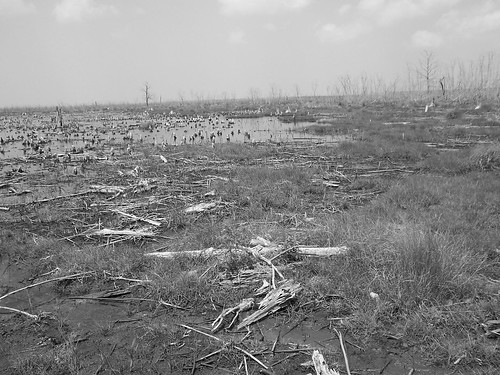
The boardwalk at Bayou Sauvage National Wildlife Refuge reopened this week, offering promise and a glimpse of what has yet to return after Hurricane Katrina. Three years after deadly winds and saltwater invasion, scores of trees and thousands of migratory birds are missing, along with hundreds of acres of marsh that made up the 23,000-acre site.

Joe Madere, a retired resident of New Orleans East gives us a little history lesson about the beginnings of this beautiful refuge:
On June 29, 1980 I retired from the New Orleans Police Department and went to work for the New Orleans East Corporation who was developing the eastern section of New Orleans. I worked for them for five years. In 1985, they went bankrupt and Merrill Lynch took over 23,457 acres, and asked me to work for them as land manager. While working for Merrill Lynch, I worked on a project to turn 19,0000 acres to the national government as a wildlife refuge. We worked on this for 5 years, and in 1990 the final papers were signed, making the 19,000 acre Bayou Sauvage Wildlife Refuge.
I got to name the refuge, Bayou Sauvage, because of the bayou, which runs right through the middle of it, that at one time was part of the Mississippi river. This bayou was formed about 600 BC and was a tributary of the Mississippi for about 1000 years, but was sealed off as the river moved further south. Today, Bayou Sauvage is a small body of water about 2 miles long, but it is in its natural state.


"I'm happy to be able to invite people back," Fortier said in spite of the stark surroundings. Few large trees remain to shade the trail, a 2/3-mile loop of raised, wooden boards just east of the Maxent Canal. But along the way strollers can catch glimpses of magnificent insects and flowers and cypress stumps poking from a pond that shimmers in the sun, catching the reflection of snowy egrets flying gracefully overhead.
The boardwalk entrance off Chef Menteur Highway is open daily from sunrise to sunset. Parking is available inside the sliding metal gate, along with new restrooms and cold-water fountains and a pavilion that weathered the storm. Fortier said he hopes to gather students there in the fall for environmental education programs, just as before Katrina.
Touted as the largest urban national wildlife refuge in the United States, Bayou Savage is roughly bounded by the Maxent Levee on the west, Lake Pontchartrain on the north, Lake Borgne on the south and Chef Pass and Lake Pontchartrain on the east.
It has taken many months to clean the area around the boardwalk and rebuild it, Fortier said. A contractor is ready to grind dead trees and brush into mulch in preparation of the massive planting of indigenous trees along the walkway come winter, he said.
Plantings will include live and water oaks, cypress, hackberry, green ash and red maple, Fortier said. The removal of invasive Chinese tallow trees will continue.
With reforestation of the refuge's forest area will come the return of neo-tropical migratory song birds and other wildlife, he said. Also anticipated is the purchase of about 1,500 acres that make up a portion of nearby land and marsh called Brazilier Island, Fortier said.
For information about the refuge and boardwalk, call (985) 882-2000.


2 comments:
Damn!
My sons were in Cub Scouts so we used to go out there a lot when I lived in Gentilly. This is so sad!
I haven't heard about this - it needs wider exposure. Thanks so much for this post! Our wild places are so important and I'm so glad to hear Bayou Savage is being reborn...it's a first step to wildlife renewal post-K.
Great post.
Post a Comment